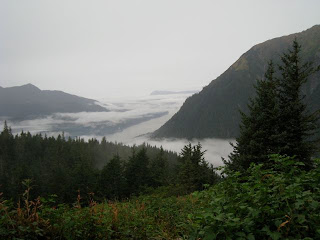Friday, September 25, 2009
KETCHIKAN, Alaska
Thursday, September 24, 2009
GLACIER BAY NATIONAL PARK, Alaska
Wednesday, September 23, 2009
SKAGWAY, Alaska
Tuesday, September 22, 2009
JUNEAU, Alaska
formed from Glaciers. The Tlingits fished the bountiful waters of
Southeast Alaska long before the Russians arrived to trade and then
settle. Their influence is still felt in the native arts and crafts,
including totems that fill the handful of fine art galleries in these
parts.
Our ship, the MS Veendam docked at 2pm just as today's morning rain
subsided. We raced ashore to catch as much clear day as we could
squeeze in. First up, a 20-minute shuttle to the Mendenhall Glacier.
The "old salt" driving our bus gave a head count of the several bears
that had been frequenting the Mendenhall area but we didn't expect to
see the mama (who had just been shot with bear-mace for acting out the
day before) and her two babies in the woods by the parking lot. We
watched from 30 feet as the disinterested cubs munched on some berries
and then the three waddled across the road and up the mountain. Not
half an hour later as we wandered toward the glacier, a little black
bear emerged from the bushes and stared at the lake before circling it
in hopes of finding a late season salmon.
Before catching a return shuttle to downtown, sprinkles returned and
we hoped our planned tram trip to the top of Mt. Roberts wasn't going
to be shrouded in a sea of fog. Alas, the canopy of clouds gave a
mysterious and ethereal feel to the views of Juneau and her beautiful
surroundings. We walked the muddy trail wrapped in our rain gear and
were grateful we'd made it ashore. On the cruise north we'd run into
two patches of rough seas. The morning portion had me seasick and in
bed eating saltines and green apples. With calm waters I staged a
recovery but the captain had warned of six more hours of a rocking
ship so we tucked into bed at 8:30, just as the dips and heaves and
clanking that made me feel like I was on a waterbed in a blender
began.
By the time we docked in Juneau, not only were my sealegs intact, but
my appetite was raging. After our trip up Mt. Roberts we stopped in at
The Hangar on the Wharf, a favorite with locals and cruisers alike for
a pre-dinner snack before donning our slickers for the walk back to
our ship amused that all the locals we met considered it "great
weather for Juneau."




























































